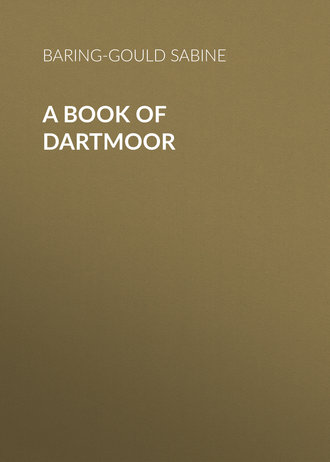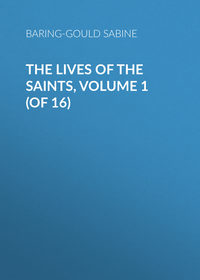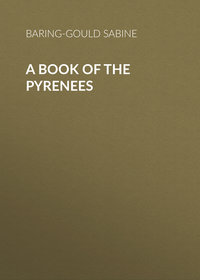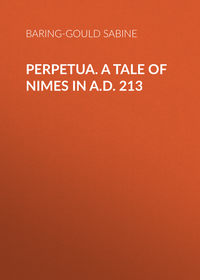 полная версия
полная версияA Book of Dartmoor
The greatest elevations are reached on the outskirts, and there, also, is the finest scenery. The interior consists of rolling upland. It has been likened to a sea after a storm suddenly arrested and turned to stone; but a still better resemblance, if not so romantic, is that of a dust-sheet thrown over the dining-room chairs, the backs of which resemble the tors divided from one another by easy sweeps of turf.
Most of the heights are crowned with masses of rock standing up like old castles; these, and these only, are tors.2 Such are the worn-down stumps of vast masses of mountain formation that have disappeared. There are no lakes on or about the moor, but this was not always so. Where is now Bovey Heathfield was once a noble sheet of water fifty fathoms deep. Here have been found beds of lignite, forests that have been overwhelmed by the wash from the moor, a canoe rudely hollowed out of an oak, and a curious wooden idol was exhumed leaning against a trunk of tree that had been swallowed up in a freshet. The canoe was nine feet long. Bronze spear-heads have also been found in this ancient lake, and moulds for casting bronze instruments. A representation of the idol was given in the Transactions of the Devonshire Association for 1875.
The new Plymouth Reservoir overlies an old lake-bed. Taw Marsh was also once a sheet of rippling blue water, but the detritus brought down in the weathering of what once were real mountains has filled them all up. Dartmoor at present bears the same relation to Dartmoor in the far past that the gums of an old hag bear to the pearly range she wore when a fresh girl. The granite of Dartmoor was not well stirred before it was turned out, consequently it is not homogeneous. Granite is made up of many materials: hornblende, feldspar, quartz, mica, schorl, etc. Sometimes we find white mica, sometimes black. Some granite is red, as at Trowlesworthy, and the beautiful band that crosses the Tavy at the Cleave; sometimes pink, as at Leather Tor; sometimes greenish, as above Okery Bridge; sometimes pure white, as at Mill Tor.
The granite is of very various consistency, and this has given it an appearance on the tors as if it were a sedimentary rock laid in beds. But this is its little joke to impose on the ignorant. The feature is due to the unequal hardness of the rock which causes it to weather in strata.
The fine-grained granite that occurs in dykes is called elvan, which, if easiest to work, is most liable to decay. In Cornwall the elvan of Pentewan was used for the fine church of S. Austell, and as a consequence the weather has gnawed it away, and the greater part has had to be renewed. On the other hand, the splendid elvan of Haute Vienne has supplied the cathedral of Limoges with a fine-grained material that has been carved like lace, and lasts well.
The drift that swept over the land would appear to have been from west to east, with a trend to the south, as no granite has been transported, except in the river-beds to the north or west, whereas blocks have been conveyed eastward. This is in accordance with what is shown by the long ridges of clay on the west of Dartmoor, formed of the rubbing down of the slaty rocks that lie north and north-west. These bands all run north and south on the sides of hills, and in draining processes they have to be pierced from east to west. This indicates that at some period during the Glacial Age there was a wash of water from the north-west over Devon, depositing clay and transporting granite.
On the sides of the tors are what are locally termed "clitters" or "clatters" (Welsh clechr), consisting of a vast quantity of stone strewn in streams from the tors, spreading out fanlike on the slopes. These are the wreckage of the tor when far higher than it is now, i. e. of the harder portions that have not been dissolved and swept away.
"The tors – Nature's towers – are huge masses of granite on the top of the hills, which are not high enough to be called mountains, piled one upon another in Nature's own fantastic way. There may be a tor, or a group of tors, crowning an eminence, but the effect, either near or afar, is to give the hilltop a grand and imposing look. These large blocks of granite, poised on one another, some appearing as if they must fall, others piled with curious regularity – considering they are Nature's work – are the prominent features in a Dartmoor landscape, and, wild as parts of Dartmoor are, the tors add a notable picturesque effect to the scene. There are very fine tors on the western side of the moor. Those on the east and south are not so fine as those on the north and west. In the centre of the moor there are also fine tors. They are, in fact, very numerous, for nearly every little hill has its granite cap, which is a tor, and every tor has its name. Some of the high hills that are tor-less are called beacons, and were doubtless used as signal beacons in times gone by. As the tors are not grouped or built with any design by Nature to attract the eye of man, they are the more attractive on that account, and one of their consequent peculiarities is that from different points of view they never appear the same. There can be no sameness in a landscape of tors when every tor changes its features according to the point of view from which you look at it. Every tor also has its heap of rock at its feet, some of them very striking jumbles of blocks of granite scattered in great confusion between the tor and the foot of the hill. Fur Tor, which is in the very wildest spot on Dartmoor, and is one of the leading tors, has a clitter of rocks on its western side as remarkable as the tor itself; Mis Tor, also on its western side, has a very fine clitter of granite; Leather Tor stands on the top of a mass of granite rocks on its east and south sides; and Hen Tor, on the south quarter, is surrounded with blocks of granite, with a hollow like the crater of a volcano, as if they had been thrown up by a great convulsion of Nature. Hen Tor is remarkable chiefly for this wonderful mass of granite blocks strewn around it. All the moor has granite boulders scattered about, but they accumulate at the feet of the tors as if for their support."3
Here among the clitters, where they form caves, a search may be made for the beautiful moss Schistostega osmundacea. It has a metallic lustre like green gold, and on entering a dark place under rocks, the ground seems to be blazing with gold. In Germany the Fichtel Gebirge are of granite, and the Luchsen Berg is so called because there in the hollow under the rocks grew abundance of the moss glittering like the eyes of a lynx. The authorities of Alexanderbad have had to rail in the grottoes to prevent the gold moss from being carried off by the curious. Murray says of these retreats of the luminous moss: —
"The wonder of the place is the beautiful phosphorescence which is seen in the crannies of the rocks, and which appears and disappears according to the position of the spectator. This it is which has given rise to the fairy tales of gold and gems with which the gnomes and cobolds tantalise the poor peasants. The light resembles that of glow-worms; or, if compared to a precious stone, it is something between a chrysolite and a cat's-eye, but shining with a more metallic lustre. On picking up some of it, and bringing it to the light, nothing is found but dirt."
Professor Lloyd found that the luminous appearance was due to the presence of small crystals in the structure which reflect the light. Coleridge says: —
"'Tis said in Summer's evening hour,Flashes the golden-coloured flower,A fair electric light."In 1843, when the luminosity of plants was recorded in the Proceedings of the British Association, Mr. Babington mentioned having seen in the south of England a peculiar bright appearance produced by the presence of the Schistostega pennata, a little moss which inhabited caverns and dark places: but this was objected to on the ground that the plant reflected light, and did not give it off in phosphorescence.4
When lighted on, it has the appearance of a handful of emeralds or aqua marine thrown into a dark hole, and is frequently associated with the bright green liverwort. Parfitt, in his Moss Flora of Devon, gives it as osmundacea, not as pennata. It was first discovered in Britain by a Mr. Newberry, on the road from Zeal to South Tawton; it is, however, to be found in a good many places, as Hound Tor, Widdecombe, Leather Tor, and in the Swincombe valley, also in a cave under Lynx Tor. If found, please to leave alone. Gathered it is invisible; the hand or knife brings away only mud.
But what all are welcome to go after is that which is abundant on every moorside – but nowhere finer than on such as have not been subjected to periodical "swaling" or burning. I refer to the whortleberry. This delicious fruit, eaten with Devonshire cream, is indeed a delicacy. A gentleman from London was visiting me one day. As he was fond of good things, I gave him whortleberry and cream. He ate it in dead silence, then leaned back in his chair, looked at me with eyes full of feeling, and said, "I am thankful that I have lived to this day."
The whortleberry is a good deal used in the south of France for the adulteration and colouring of claret, whole truck-loads being imported from Germany.
There is an interesting usage in my parish, and I presume the same exists in others. On one day in summer, when the "whorts" are ripe, the mothers unite to hire waggons of the farmers, or borrow them, and go forth with their little ones to the moor. They spend the day gathering the berries, and light their fires, form their camp, and have their meals together, returning late in the evening, very sunburnt, with very purple mouths, very tired maybe, but vastly happy, and with sufficient fruit to sell to pay all expenses and leave something over.
If the reader would know what minerals are found on Dartmoor he must go elsewhere.
I have a list before me that begins thus: "Allophane, actinolite, achroite, andalusite, apatite" – but I can copy out no more. I have often found appetite on Dartmoor, but have not the slightest suspicion as to what is apatite. The list winds up with wolfram, about which I can say something. Wolfram is a mineral very generally found along with tin, and that is just the "cussedness" of it, for it spoils tin.
When tin ore is melted at a good peat fire, out runs a silver streak of metal. This is brittle as glass, because of the wolfram in it. To get rid of the wolfram the whole has to be roasted, and the operation is delicate, and must have bothered our forefathers considerably. By means of this second process the wolfram, or tungsten as it is also called, is got rid of.
Now, it is a curious fact that the tin of Dartmoor is of extraordinary purity; it has little or none of this abominable wolfram associated with it, so that it is by no means improbable that the value of tin as a metal was discovered on Dartmoor, or in some as yet unknown region where it is equally unalloyed.
In Cornwall all the tin is mixed with tungsten. Now this material has been hitherto regarded as worthless; it has been sworn at by successive generations of miners since mining first began. But all at once it has leaped into importance, for it has been discovered to possess a remarkable property of hardening iron, and is now largely employed for armour-plated vessels. From being worth nothing it has risen to a rapidly rising value, as we are becoming aware that we shall have to present impenetrable sides to our Continental neighbours.
Dartmoor comprises the "forest" and the surrounding commons, as extensive together as the forest itself. "What have you got on you, little girl?" asked a good woman of a shivering child. "Please, mem, first there's a jacket, then a gownd, and then comes Oi." So with Dartmoor. First come the venville parishes, next their extensive commons, and "then comes Oi," the forest itself.
The venville parishes are all moorland parishes – Belstone, Throwleigh, Gidleigh, Chagford, North Bovey, Manaton, Widdecombe, Holne, Buckfastleigh, Dean Prior, South Brent, Shaugh, Meavy, Sheeps Tor, Walkhampton, Sampford Spiney, Whitchurch, Peter Tavy, Lydford, Bridestowe, Sourton. There are others, standing like the angel of the Apocalypse, with one foot on the moorland, the other steeped in the green waves of foliage of the lowlands; such are South Tawton, Cornwood, and Tavistock. Others, again, as Lustleigh, Bridford, Moreton, Buckland-in-the-Moor, Ilsington, and Ugborough, must surely have been moorland settlements at one time, and Okehampton itself is as distinctly a moor town as is Moreton, which tells its own tale in its name. But all these have their warm envelope of arable land, groves and woods, farms and hamlets. Such have their commons, over which every householder has a right to send cattle, to take turf and stone, and, alas! with the connivance of the other householders, to inclose. This inclosing has been going on at a great rate in some of the parishes. For instance, common rights are exercised by the householders of South Zeal over an immense tract of land on the north side of Cosdon. Of late years they have put their heads together and decided, as they are few in number, to appropriate it to themselves as private property, and inclosures have proceeded at a rapid rate.
In Bridestowe there is a tract of open land on which the poor cotters have, from time immemorial, kept their cows. But they are tenants, and not householders, and have consequently no rights. The seven or eight owners have combined to inclose and sell or let for building purposes all that tract of moor, and the cotters have lost their privilege of keeping cows. What we see now going on under our eyes has been going on from time immemorial. Parishes have encroached, and the genuine forest has shrunk together before them. The commons still exist, and are extensive, but they are being gradually and surely reduced. "Then comes Oi!" Look at the map and see of what the forest really consists. It surely must have been larger formerly.
On the forest itself are a certain number of "ancient tenements," thirty-five in all. These are of remote antiquity. On certainly most of them, probably on all, the plough and the hoe turn up numerous flint tools, weapons, and chips – sure proof that they were settlements in prehistoric times. These tenements are at Brimpts, Hexworthy, Huccaby, Bellever, Dunnabridge, Baberry, Pizwell, Runnage, Sherberton, Riddons, Merripit, Hartland, Broom Park, Brown Berry, and Prince Hall. These were held – and some still are – by copy of the Court Roll, and the holders are bound to do suit and service at the Court. It is customary for every holder on accession to the holding to inclose a tract of a hundred acres, and this inclosure constitutes his newtake.
The forest belongs to the Prince of Wales, but I believe has never been visited by him. Were he to do so, he would be surprised, and perhaps not a little indignant, to see how his tenants are housed. A forest does not necessarily signify a wood. It is a place for wild beasts. The origin of the word is not very clear. Lindwode says, "A Forest is a place where are wild beasts; whereas a Park is a place where they are shut in." Ockam says, "A Forest is a safe abode for wild beasts," and derives the word from feresta, i. e. a place for wild creatures. It was, in fact, a tract of uninclosed land reserved for the king to hunt in, and a chase was a similar tract reserved by the lord of the manor for his own hunting.
It is more than doubtful whether Dartmoor was ever covered with trees. No doubt there have been trees in the bottoms, and indeed oak has been taken from some of the bogs; but the charcoal found in the fire-pits of the primitive inhabitants of the moor in the Bronze Age shows that, even in the prehistoric period, the principal wood was alder, and that such oak as there was did not grow to a large size, and was mainly confined to the valleys that opened out of the moor into the lowlands. Up these, doubtless, the forest crept. Elsewhere there may have been clusters of stunted trees, of which the only relics are Piles and Wistman's Wood. There were some very fine oaks at Brimpts, and also in Okehampton Park, but these were cut down during the European war with Napoleon. After the wood at Brimpts had fallen under the axe, it was found that the cost of carriage would be so great that the timber was sold for a mere trifle, only sufficient to pay for the labour of cutting it down.
The forest is divided into four quarters, in each of which, except the western, is a pound for stray cattle. Formerly the Forest Reeve privately communicated with the venville men when he had fixed a day for a "drift," which was always some time about midsummer. Then early in the morning all assembled mounted. A horn was blown through a holed stone set up on a height, and the drift began. Cattle or horses were driven to a certain point, at which stood an officer of the Duchy on a stone, and read a proclamation, after which the owners were called to claim their cattle or ponies. Venville tenants removed them without paying any fine, but all others were pounded, and their owners could not recover them without payment of a fine.
The Duchy Pound is at Dunnabridge, where is a curious old seat within the inclosure for the adjudicator of fines and costs. It is apparently a cromlech that has been removed or adapted. The Duchy now lets the quarters to the moormen, who charge a small fee for every sheep, bullock, or horse turned out on the moor not belonging to a venville man, and for this fee they accord it their protection.
A good deal of money has been expended on the reclaiming of Dartmoor. Sir Thomas Tyrwhitt, Usher of the Black Rod, was Warden of the Stannary and Steward of the Forest for George IV. when Prince of Wales. He fondly supposed that he had discovered an uncultivated land, which needed only the plough and some lime to make its virgin soil productive. He induced others to embark on the venture. Swincombe and Stannon were started to become fine farm estates. Great entrance gates were erected to where mansions were proposed to be built. But those who had leased these lands found that the draining of the bogs drained their pockets much faster than the mires, and abandoned the attempt which had ruined them. Others followed. Prince's Hall was rebuilt with fine farm buildings by a Mr. Fowler from the north of England, who expended his fortune there and left a disappointed man. Before him Sir Francis Buller, who had bought Prince's Hall, planted there forty thousand trees – such as are not dead are distorted starvelings. Mr. Bennett built Archerton, near Post Bridge, and inclosed thousands of acres. He cannot have recovered a sum approaching his outlay in the sixty years of his tenancy. The fact is that Dartmoor is cut out by Nature to be a pasturage for horses, cattle, and sheep in the summer months, and for that only. In the burning and dry summers of 1893, 1897, and 1899 tens of thousands of cattle were sent there, even from so far off as Kent, where water and pasturage were scarce, and on the moor they both are ever abundant.
Tenements there must be, but they should be in the sheltered valleys, and the wide hillsides and sweeps of moor should be left severely alone. As it is, encroachments have gone on unchecked, rather have been encouraged. Every parish in Devon has a right to send cattle to the moor, excepting only Barnstaple and Totnes. But the Duchy, by allowing and favouring inclosures, is able to turn common land into private property, and that it is only too willing to do.
Happily there now exists a Dartmoor Preservation Society, which is ready to contest every attempt made in this direction. But it can do very little to protect the commons around the forest – in fact it can do nothing, if the freeholders in the parishes that enjoy common rights agree together to appropriate the land to themselves – and for the poor labourer who is able to buy himself a cow it can do nothing at all, for his rights have no legal force.
CHAPTER III
THE ANCIENT INHABITANTS
Abundance of remains of primeval inhabitants – No trace of Briton or Saxon on Dartmoor – None of Palæolithic man – The Neolithic man who occupied it – Account of his migrations – His presence in Ireland, in China, in Algeria – A pastoral people – The pottery – The arrival of the Celt in Britain in two waves – The Gael – The Briton – Introduction of iron – Mode of life of the original occupants of the moor – The huts – Pounds – Cooking – Tracklines – Enormous numbers who lived on Dartmoor – A peaceable people.
Probably no other tract of land of the same extent in England contains such numerous and well-preserved remains of prehistoric antiquity as Dartmoor.
The curious feature about them is that they all belong to one period, that of the Early Bronze, when flint was used abundantly, but metal was known, and bronze was costly and valued as gold is now.
Not a trace has been found so far of the peoples who intervened between these primitive occupants and the mediæval tin-miners.
If iron was introduced a couple of centuries before the Christian era, how is it that the British inhabitants who used iron and had it in abundance have left no mark of their occupancy of Dartmoor? It can be accounted for only on the supposition that they did not value it. The woods had been thinned and they preferred the lowlands, whereas in the earlier period the dense forests that clothed the country were too close a jungle and too much infested by wolves to be suitable for the habitation of a pastoral people.
That under the Roman domination the tin was worked on the moor there is no evidence to show. No Roman coins have been found there except a couple brought by French prisoners to Princetown.
It may be said that iron would corrode and disappear, whereas flint is imperishable, and bronze nearly so. But where is Roman pottery? Where is even the pottery of the Celtic period? An era is distinguished by its fictile ware. A huge gap in historic continuity is apparent. All the earthenware found on Dartmoor is either prehistoric or mediæval, probably even so late as the reign of Elizabeth.
No indication is found that the Saxons worked the tin or even drove their cattle on to the moor. In Domesday Book Dartmoor is not even mentioned. It is hard to escape the conclusion that from the close of the prehistoric period to that of our Plantagenet kings, Dartmoor was avoided as a waste, inhospitable region.
Of man in the earliest period at which he is known to have existed – the so-called Palæolithic man – not a trace has been found on Dartmoor. Probably when he lived in Britain the whole upland was clothed in snow. He has left his tools in the Brixham and Torquay caves – none in the bogs of the moor. Indeed, when these bogs have been dug into, there are not the smallest indications found of man having visited the moor before the advent of what is called the Neolithic Age.
About the man of this period I must say something, as he in his day lived in countless swarms on this elevated land. He may have lived also in the valleys of the lowlands, but his traces there have been obliterated by the plough. First of all as to his personal appearance. He was dark-haired, tall, and his head was long, like that of a new-born child, or boat-shaped, a form that disappears with civilisation, and resolves itself into the long face instead of the long head.
At some period, vastly remote, a great migration of a long-headed race took place from Central Asia. It went forth in many streams. One to the east entered Japan; probably the Chinese and Anamese represent another. But we are mainly concerned with the western outpour. It traversed Syria, and Gilead and Moab are strewn with its remains, hut circles, dolmens, and menhirs identical with those on Dartmoor. Hence one branch passed into Arabia, where, to his astonishment, Mr. Palgrave lighted on replicas of Stonehenge.5
Another branch threw itself over the Himalayas, and covered India with identical monuments. Again another turned west; it traversed the Caspian and left innumerable traces along the northern slopes of the Caucasus. The Kuban valley is crowded with their dolmens. They occupied the Crimea, and then struck for the Baltic. That a branch had passed through Asia Minor and Greece, and constituted itself as the Etruscan power in Italy, is probable but not established. The northern stream strewed Mecklenburg and Hanover with its remains, occupied Denmark and Lower Sweden, crossed into Britain, and took complete possession of the British Isles. Other members of the same swarm skirted the Channel and crowded the plateaux and moors of Western and Central France with their megalithic remains. The same people occupied Spain and Portugal, the Balearic Isles, Corsica and Sardinia, and Northern Africa, and are now represented by the Koumirs and Kabyles. To this race the name of Iberian, Ivernian, or Silurian has been given. It contributed its name to Ireland (Erin or Ierne), where it maintained itself, but was known to the conquering Gaels as the Tuatha da Danann and Firbolgs, two branches of the same stock. The name of Damnonia given to Devon is probably due to these same Danann, who were also found in the south of Scotland. When this great people reached Europe, Japan, India, Africa, before its branches had begun to ramify to east and west, to south and north, its religious doctrines and its practices had become stereotyped, and almost ineradicably ingrained into the consciousness of the entire stock.









